#teen idol the 1960s
Explore tagged Tumblr posts
Text
Time period post: Shaping style and standards

This one comes by request and I hope I fufill it, as I think I go too far off on a side tangent. I was asked about beauty standards and I’m going to focus here on teenagers since a majority of the characters are, during this time they had a lot of say in shaping it! I’m going to focus on the early to mid 60s, as that’s when the Outsiders take place and post 1967 there are HUGE shifts.
Conformity and codes -
The start of every decade tends to be a reflection of the one that came before, so the early 60s is one of muted colors and a strict conformity. Long skirts, short clean hair on guys, formal shoes and so on. Now it’s not as authoritative as that, though to high schoolers it certainly felt like it with continual checks on your attire — for ladies its skirt length and for guys its hair length, as it was slightly longer than it was in the 50s but only by a certain degree. Strict and clean cut.
As it starts to get into the decade the rebellion that began in the last really starts to ramp, and teens get a little more bold. Longer hair, sideburns, short skirts- sneakers! Sneakers slowly become more acceptable footwear (Canvas and leather) though strictly for casual or sport related events. Colors themselves become brighter and so do patterns, women have been wearing pants occasionally since the 20s but the acceptability rises, huggable fit pants, capris. Jeans are still work wear or the most casual of casual clothing.
There’s still an etiquette and form to follow but the lines start to shift and be pushed and pulled by testing teenagers. The baby boom meant a whole lot more youth, and especially teenagers- a demographic now loud and listened to… if even a little tiny bit.
While playfulness existed before it’s the saturation that’s noticeable. Youth start shaping clothing right back.


Rock n’ roll rebellion-
Rock and music both play a huge roll in the shift in culture and in fashion. Not only is music a way to express themselves but so is the types of music, often came with imitating artists attitudes and styles (Elvis -> pompadour and leather booms in popularity) Kids wanted to look nothing like their parents, and fashion became a tool of rebellion. Dress codes forced creativity, ways to push and subtlety implement their style while staying within the lines to be safe- the older you got the more freedom to dress. Even in conservative towns teens found ways to express themselves.
It was about individuality, even if often times that just meant finding another group or style to belong to. A different style and belief to conform to.
You still dressed nice, don’t mishear me we aren’t quite talking hippies (as that’s the end of the decade) or punks (of the 70s fashion variety.) But expressing yourself in the current fashion was the way to go in a lot of ways. Trading the long skirt and buffont for a mini skirt and flips (hair) or whatever was popular where you lived (not everyone just became mod the second 1965 hit. There’s so many styles) it’s making it clear you aren’t your parents.
The greasers really stick out as underdressed for their time, in jeans and t-shirts and sneakers or boots. All not your typical clothing and with them— what they could afford or had but also a way to again express themselves. Sticking with the hair of greasers from the 50s , jackets and shirts and Elvis/ rock n’ roll instead of the new group or idol on the scene. Their hair is probably what got them in the most trouble at school, depending on code. They did ‘long’ hair before it was cool.

Body shape and youthfulness-
Body standards changed in the mid 1960s, curvy fuller figures were out for more rail thin, almost boyish appeal that was still distinctly feminine. A incredible focus on youthfulness and low weight. It also saw less emphasis on breasts, in some forms.
Twiggy is the greatest example of the look many tried to imitate:

Teens for the first time were choosing their own makeup too, not just doing what their mother did or movie stars. They were shaped by magazines and models and stars— music acts and the culture of the time. Cat eye -> in the later half of the decade it was the cut crease, big painted lashes and big looking eyes (think Shelly Duval)
Boys would see a particular emphasis on a tan, sideburns and smile, it was more what they wore than a particular body weight to my understanding. Muscle was not mainstream, you just wanted a healthy moderate appeal.
But it’s important to keep in mind that what magazines pushed v. The reality to most people isn’t always one to one, and the slower travel of information. While thin was ‘in’ most were at a healthy lower weight from lifestyle than a standard, or tanning had broadly been thought to be good for health not just because of a magazine. Teens immolated stars and big city or even foreign (British invasion) looks but they picked and chose and made their own! (If trying to follow/copy anyone at all!)
What was worn-
Mentioned above but the decade was largely shaped by both the conservatism and the rebellion to it— and both existing at once in a strange way. You’d dress to the code at a hop but casual events teens had the true freedom and playful, tighter and shorter appeal (even for guys)
For the Outsiders it really is the dead center of the 60s where the long skirt and more formal clothes existed but the mini skirt also became prevalent. Keep in mind one thing does not stop existing because the other! Not to mention affordability a majority of people don’t just drop everything and have an all new in style wardrobe for every slight shift.
Many clothes during this time were also handmade! By all walks of life, changing an old outfit to fit current standards has been around since before even the 1800s. During the 60s buying clothing patterns in the current style hit a particular high. There was clothes off the rack too but if you really wanted to be that individual ™️ you’d get a fabric of your own desire. People sew a lot more, so they patched a lot more- especially lower income.


Hair is an interesting point I’ve touched on it before but it started the decade big and ended the decade big and long but there was a period where straight and long dominated (and in the 70s too, for some). It starts a little long and ends even longer for guys, more emphasis on sideburns and styling it- though just a bit below the collar. Not to say there wasn’t a bunch of “long hairs” of different demographics who faced scrutiny still despite the popularity. Also keep in mind “long” to 1960s standards - especially for guys varied. To some even slightly down the neck constituted “long” when you hear that don’t instantly think late 60s John Lennon as that’s down the line and only a few cases/more hippie than mainstream or even grease.
Curls! Natural hair! There was a big shift towards natural hair in parts of the black community in the mid and late 60s, it started as a statement and then became gradually more accepted , typically in youth statements. By the 70s Fro’s — both black and white were just another common hairstyle.
Flairs and bellbottoms, which seem like a mandatory item of clothing in the 1970s also got their start in the late 60s.
Celebrity -
What’s attractive? Look no further than the teen idol, dreamy eyed hunks or sweet looking gals who song poppy versions of rock numbers or hit the screen with their own work, often love songs.
Something to note here too is celebrities had their own faces. Their own teeth, their own nose— there were procedures sure but people still looked unique, like themselves! This was far from the time of homogeny… even if there was conformity.



I hope this is helpful! It ended up being more influenced and factors than fashion itself but there’s, so so much out there. What’s helped me at least is looking up fashion by year or seeing magazines/movies etc from that year or set in it to help a bit. Like for example the Outsiders is 1965-1966 Tulsa but still long skirt heavy, but you can see it also branching out / more individual styles. Like for example Randy and Bob are mentioned to have “semi-Beatle��� haircuts, like the band so that influence of big cities, the British etc is there too!
#the outsiders#outsiders#time period post#time period post: fashion and standards#1960s#1960s fashion#teen idols#60s pop music#60s magazines#teen culture
19 notes
·
View notes
Text

#1960s#micky dolenz#the monkees#child star#circus boy#striped sweater#red and black#teen idol#it boy#so cute
20 notes
·
View notes
Text
Remembering Deborah Walley 🌹🕊️
On her Birthday 🎂
✨August 12th 1941✨💫
11 notes
·
View notes
Text
Found this at the antique mall a few days ago, it was glorious. Not a page colored or messed with. Was half tempted but not really a major fan


2 notes
·
View notes
Text

Entertainer Tommy Steele (1936) was Britain's first teen idol and rock 'n roll star. His cheeky Cockney image and boy-next-door looks won him success as a musician, singer and actor.
4 notes
·
View notes
Text
Teen idols, singers and actors of the 1960s - Frankie Avalon and Fabian (Forte).

292 notes
·
View notes
Text

Remembering the legendary actor Richard Chamberlain, who was born on March 31, 1934, and passed away on March 29, 2025, just shy of his 91st birthday. Chamberlain rose to fame in the 1960s as a teen idol, starring in the title role of the TV series *Dr. Kildare*. He later became widely recognized for his iconic performances in the 1980s television miniseries *Shogun* and *The Thorn Birds*. Among his notable film roles, he delivered a standout performance as Julie Christie's sinister, subtly queer-coded husband in Richard Lester's acclaimed 1968 film *Petulia*.
Throughout much of his career, Chamberlain kept his personal life private, choosing to remain closeted to safeguard his privacy and professional opportunities. He was publicly outed by the French magazine *Nous Deux* in December 1989 but did not personally address his sexuality until the release of his 2003 autobiography, *Shattered Love: A Memoir*. Chamberlain spent his later years in Hawaii, where he lived a quiet life with his longtime partner, Martin Rabbett. He will be remembered as a trailblazing actor and a beloved figure in the entertainment world."
68 notes
·
View notes
Text
THIS DAY IN GAY HISTORY
based on: The White Crane Institute's 'Gay Wisdom', Gay Birthdays, Gay For Today, Famous GLBT, glbt-Gay Encylopedia, Today in Gay History, Wikipedia, and more … January 27


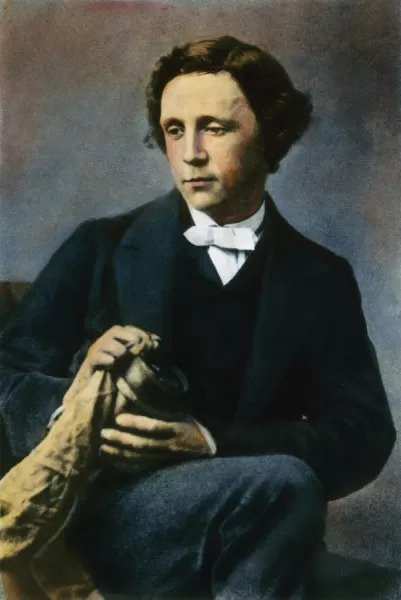
1832 – Lewis Carroll (d.1898) is born in Baresbury, England, named Charles Lutwidge Dodgson. He was an English writer, mathematician, logician, Anglican deacon, and photographer. His most famous writings are Alice’s Adventures in Wonderland, its sequel Through the Looking-Glass, which includes the poem “Jabberwocky“, and the poem The Hunting of the Snark – all examples of the genre of literary nonsense. He is noted for his facility at word play, logic and fantasy.
Carroll came from a family of high-church Anglicans, and developed a long relationship with Christ Church, Oxford, where he lived for most of his life as a scholar and teacher. Alice Liddell, daughter of the Dean of Christ Church, Henry Liddell, is widely identified as the original for Alice in Wonderland, though Carroll always denied this.
Carroll never married and his sexual identity is the subject of exploration by many historians an biographgers.

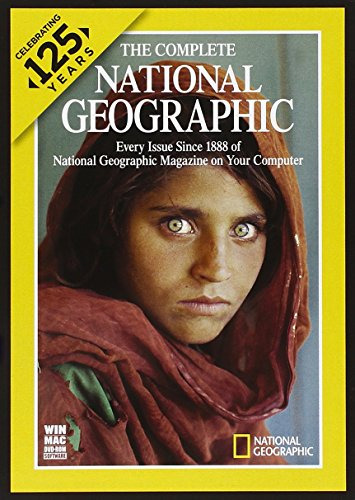
1888 - The National Geographic Society was founded In Washington, D.C. They are justly famous for many things but mainly for their magazine and for many gay men, the photographs of naked tribesmen featured in the pages of that yellow-spined National Geographic was their first look at the male form in its glory. ("What? Oh, I'm just interested in ethnography, mother.")

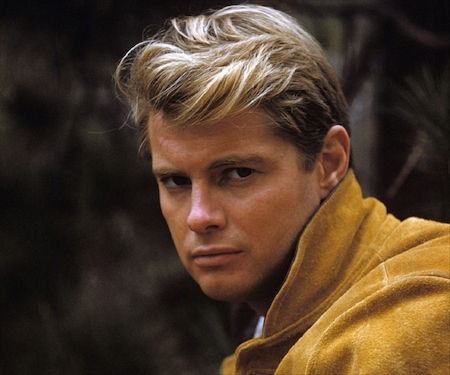
1936 – Troy Donahue, born in New York City (d.2001) was an American actor, known for being a teen idol.
Born Merle Johnson Jr, he was initially a journalism student at Columbia University before he decided to become an actor in Hollywood, where he was represented by Rock Hudson's agent, Henry Willson. According to Robert Hofler's 2005 biography, "The Man Who Invented Rock Hudson: The Pretty Boys and Dirty Deals of Henry Willson," Willson tried out the name Troy on Rory Calhoun and James Darren, with no success, before it finally stuck to Donahue.
The blond heartthrob made a name for himself with uncredited roles in The Monolith Monsters (1957) and Man Afraid (1957); leading to larger parts in several other films, including Monster on the Campus (1958), Live Fast, Die Young (1958), and opposite fellow teen idol Sandra Dee in A Summer Place (1959). A Summer Place was a hit and made Donahue a name, especially among teenaged audiences. He signed a contract with Warner Bros., and met actress Suzanne Pleshette on the set of Rome Adventure. They married in 1964 but divorced later that year.
Warner Bros. put him in a TV series, Surfside 6 (1960–62), one of several spin-offs of 77 Sunset Strip, announced in April 1960. On Surfside 6, Donahue starred with Van Williams, Lee Patterson, Diane McBain, and Margarita Sierra in the ABC series, set in Miami Beach, Florida. After Surfside 6 was cancelled, Donahue joined the cast of Hawaiian Eye, another spinoff of Sunset Strip, for its last season from 1962 to 1963 in the role of hotel director Philip Barton.
After the release of My Blood Runs Cold (1965), Donahue's contract with Warner Bros. ended. He later struggled to find new roles and had problems with drug addiction, alcoholism, and his closeted homosexuality.
He was married again in 1966, to actress Valerie Allen, but they divorced in 1968. In 1970 he appeared in the daytime drama The Secret Storm.
By this time, Donahue's drug addiction and alcoholism had ruined him financially. One summer, he was homeless and lived in Central Park. "There was always somebody who could be amused by Troy Donahue", he says. "I'd meet them anywhere, in a park, street, party, in bed. I lived in a bush in Central Park for one summer. I kept everything I had in a backpack."
After his fourth marriage ended in 1981, Donahue decided to seek help for his drinking and drug use. In May 1982, he joined Alcoholics Anonymous, which he credited for helping him achieve and maintain sobriety. "I look upon my sobriety as a miracle", he says. "I simply do it one day at a time. The obsession to not drink has become as big as the obsession to drink. I was very fortunate."
Donahue continued to act in films throughout the 1980s and into the late 1990s. However, he never obtained the recognition that he had in the earlier years of his career.
On August 30, 2001, Donahue suffered a heart attack and was admitted to Saint John's Health Center in Santa Monica. He died three days later on September 2 at the age of 65.

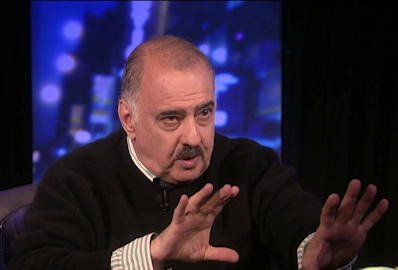
1949 – American author, essayist and cultural critic Ethan Mordden was born today. His stories, novels, essays, and non-fiction books cover a wide range of topics including the American musical theater, opera, film, and, especially in his fiction, the emergence and development of contemporary American Gay culture as manifested in New York City. He has also written for The New Yorker, including fiction, "Critic At Large "pieces on Cole Porter, Judy Garland, and the musical Show Boat, and reviews of a biography of the Barrymores and Art Spiegelman's graphic novel Maus.
His best known fictional works are the inter-related series of stories known collectively as the "Buddies" cycle. In book form, these began with 1985's I've a Feeling We're not in Kansas Anymore. The fifth in the series, 2005's How's Your Romance?, is subtitled Concluding the "Buddies" Cycle. Together, the stories chronicle the times, loves, and losses of a close-knit group of friends, men who cope with the challenges of growing up and growing older. In this circle of best friends, teasing putdowns become performance art, but none of the friends ever attacks any other friend's sensitive spots.
Mordden thus breaks away from the gay model proposed by Mart Crowley's play The Boys in the Band, in which supposed best friends assault one another relentlessly in a style that has bedeviled gay art ever since, for instance in the television series Queer As Folk. Mordden's ideal of Gay friendship presents men who genuinely like themselves and one another. They are unique in Gay lit in that they respect the limits of privacy. This explains their devotion to one another: this "family" is a safe place.

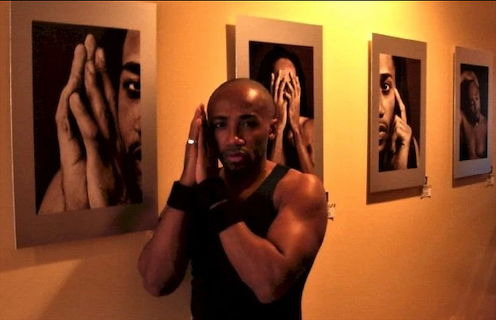
1966 – Taylor Siluwé, popular writer, blogger and activist was born in Jersey City, where he lived most of his adult life. He studied creative writing at New York University, fulfilling what he considered “a burning passion to write.”
Known for his darkly erotic and humorous story telling style, Taylor’s writing has been featured in numerous publications including Details, Venus, Literary New York, Out IN Jersey, FlavaLIFE, and the E-zine Velvet Mafia. His short stories appeared in the anthologies Law of Desire and Best Gay Erotica 2008. In addition, Taylor published two sexually charged short story collections, Dancing With the Devil and Cheesy Porn…and other Fairy Tales.
Taylor’s writing reached new heights of popularity on his blog, SGL Café.Com, which combined a canny combination of the personal and political. Taylor’s blog served has a fiery, and often hilarious, platform for the rights of same-gender-loving men, while also providing insightful and candid asides on his personal life, popular culture and his struggle with cancer.
On Sunday, June 19, 2011, Taylor Siluwé died from lung cancer in his home in New Jersey. He was 43 years old.


Radford with Duhamel
1985 – Eric Radford is a Canadian pair skater. With skating partner Meagan Duhamel, he is a two-time World bronze medalist (2013 and 2014), the 2013 Four Continents champion, the 2014-15 Grand Prix Final champion, and a three-time Canadian national champion (2012-14).
Radford began skating when he was eight years old. He competed with Sarah Burke on the ISU Junior Grand Prix series in 2003 in the Czech Republic and 2004 in Hungary, placing 6th and 5th respectively. He also competed in single skating. At the 2005 Canadian Championships, he became trapped in an elevator just before he was scheduled to skate in the men's qualifying round but eventually escaped and was able to compete.
Radford teamed up with Rachel Kirkland in 2005. They were coached by Brian Orser in Toronto and part-time by Ingo Steuer in Chemnitz, Germany. They competed at the 2007 Canadian Championships where they finished 5th. After finishing 7th at the 2009 Canadian Championships, they ended their partnership.
Radford moved back to Montreal in 2009. He teamed up with Anne-Marie Giroux and finished 8th at the 2010 Canadian Championships.
At a coach's suggestion, Radford had a tryout with Meagan Duhamel and they decided to compete together. They won a silver medal at the 2011 Canadian Championships and were assigned to the Four Continents and World Championships. At Four Continents, the pair won a silver medal. During the short program at the 2011 World Championships, Radford's nose was broken when Duhamel's elbow hit him on the descent from a twist, their first element – she opened up too early. Seeing the blood, Duhamel suggested they stop, but he decided to continue. They finished the program without a pause. Duhamel had not done a triple twist since 2005, and the new pair only began performing it before the Canadian Championships.
In the 2011–12 season, Duhamel/Radford won bronze medals at their Grand Prix events, the 2011 Skate Canada and 2011 Trophée Eric Bompard. They won their first national title and finished 5th at the 2012 World Championships. The next season, Duhamel/Radford won silver at their Grand Prix events, the 2012 Skate Canada International and 2012 Trophée Eric Bompard. They then won their second national title and their first Four Continents title. Duhamel/Radford stepped onto the World podium for the first time at the 2013 World Championships in London, Ontario where they won the bronze medal.
In 2014, Duhamel/Radford skated their short program to music composed by Radford as a tribute to his late coach Paul Wirtz. After finishing seventh at the 2014 Winter Olympics in Sochi, they returned to the podium at the 2014 World Championships, where they scored personal bests in both the short program and the free skate on their way to a second bronze medal.
In December 2014, Radford publicly came out as gay in an interview with the LGBT publication Outsports. In doing so, he became the first competitive figure skater ever to come out at the height of his career while still a contender for championship titles, rather than waiting until he was near or past retirement; at the 2015 World Figure Skating Championships, Radford and Duhamel's gold medal win in pairs skating made him the first openly gay figure skater ever to win a medal at that competition. He is an ambassador for the Canadian Olympic Committee's #OneTeam program to combat homophobia in sports.
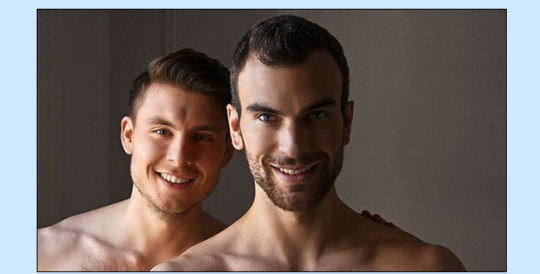
Radford with husband Fenero
Radford became engaged to his boyfriend, Spanish ice dancer Luis Fenero, on June 10, 2017. They wed on July 12, 2019.
Radford coaches skating in addition to competing. He studied music at York University, and plays piano and writes and composes music, and is registered as a member of the Society of Composers, Authors and Music Publishers of Canada.

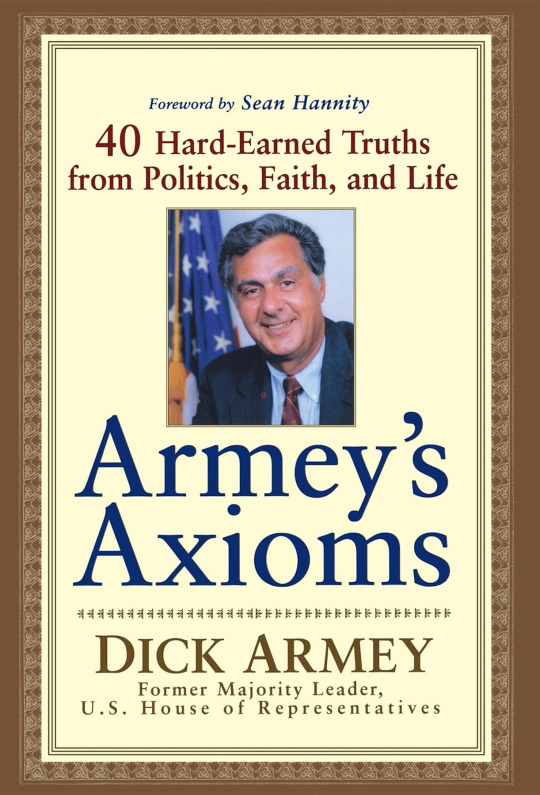
1995 – At a press conference in Washington, DC, the House majority whip, Dick Armey, refers to Representative Barney Frank as 'Barney Fag.' He later apologizes, insisting it was a slip of the tongue.


15 notes
·
View notes
Text


But Just in Time, the new musical about the life of legendary singer Bobby Darin starring Tony winner Jonathan Groff, is proving to be something different.
Directed and developed by Tony winner Alex Timbers, based on an original concept by Ted Chapin, the musical — which begins performances March 28 at New York City's Circle in the Square Theatre — takes theatergoers into an intimate nightclub, where a cast of 16 will bring Darin's story to life through his catalog of hits.
It's a fully immersive experience unlike what audiences may have seen before. But as Groff, 39, told reporters at a Feb. 5 press preview, it was a necessary move to fully showcase Darin's power as a live act.
"We're playing a little bit with form and style and form to recreate the in-the-moment live magic that Bobby Darin had as a performer," he shared with The Broadway Show with Tamsen Fadal at the event, held at Hell's Kitchen piano bar So & So's — photos from which PEOPLE can debut exclusively.
The show will begin, Groff explained, with the actor as himself in 2025 before transporting audiences back to the 1950s and 1960s, when Darin rose to fame.
"Alex and Jonathan, they've found a way to take a historical story and make it feel very present," star Erika Henningsen notes to PEOPLE. "This is not a typical show. What's happening here is unique among the mix of what's on Broadway.
The actress, returning to Broadway for the first time since originating the role of Cady Heron in 2018's Mean Girls: The Musical, is portraying sun-kissed teen idol Sandra Dee in Just in Time.
"Proscenium-style shows that we're used to seeing on Broadway and are great as exhibiting a certain story. But for Bobby Darin's story, you need to feel him on top of you," says Henningsen, 32. "It's all about bringing people into that live experience and making them feel like they're in the living room with Bobby and Sandra, like they're in the Copacabana and like Bobby's audiences felt when he was performing."
"Bobby really told Sandra, 'There's more out there than your mom allows you to do,' and that was so powerful for her," Henningsen says. "She started her career in Hollywood at a very young age as a child model, and was fiercely protected by her mother and by the studio as she grew into an actress. She hadn't really had a real womanly adult experience until she met Bobby, so in a way, he kind of saved her from this life of arrested development."
She's also looking forward to bringing Dee and Darin's partnership to life. Though Dee's film career would ultimately take a backseat to Darin's musical aspirations, Henningsen explains that the two were one another's ultimate cheerleaders.
"They really respected one another's talent and they really respected one another's drive," Henningsen says. "And that's pretty rare for two people who had this much acclaim, because so often you hear about one person begrudging the other for their success."
She adds, "But even after their divorced, that respect was there because they saw that part of themselves in one another. They both had that fire. Sandra saw how driven Bobby was and said, 'I can't get mad at you for doing the thing that you were born to do.' "
17 notes
·
View notes
Text

#1960s#johnny tillotson#r.i.p.#rest in peace#poetry in motion#keeps on right a-hurtin'#teen idol#grammy nominee#singer songwriter#black and white photography
6 notes
·
View notes
Note
Hiiii! I heard about your RAE/CEC/WP5 Au and I am OBSESSED! I am just wondering if you have any more WP5 info, like the Wolfman's relationship with his wife and son, and just the lore in general!
:3
Okay it’s all below the cut warning it’s a LOT
General note this all takes place around 1950/1960
Wolfman (jack dewolfe) has a SUPER dysfunctional relationship with his family even before and after wolfpacks tour he was never home, he would just send money and if you were lucky call. He didn’t want to be a family man or a father, his marriage was caused by teenage stupidity and a shitty Cadillac (ie Rolfe’s conception caused his parents to get married)
This puts his long standing dreams of a music career on hold, and caused a lot of resentment towards both his wife and son.
His wife is Delilah (wolfman) dewolf she’s done her best to be the best wife she can be because she thinks that that’s going to make her feel “normal”. She’s kind of petty and immature but by far a better person than jack. She dislikes most of the band they’re “rowdy” and one of them smells like pot all the time (beach bear ofc) she absolutely detests queenie bc she thinks she’s a husband stealing harlot (that is NOT happening at all as the creator I can confirm)
Which is BAD if it was happening and she wouldn’t have called someone and gotten mad at queenie (who is a TEENAGER)
(Side note I wanna talk about queenie cause I love how angsty I made this all, so her and Mitzi are supposed to sort of foil each other in how they were treated as child performers, I want to highlight the lack of protections queenie had in the 60’s not that anything ever did happen to her but it COULD have and that’s just as important and that sort of motivates her to make sure Mitzi is protected)
Delilah and jack do not get along, which is to be excepted when you consider the foundation for their marriage. He’s not around Rolfe enough to have a real relationship with him, sometimes he likes the praise and awe rolfe gives him but most of the time he chastises and mocks Rolfe for his puppets and less than masculine interests (I think he was some inspiration for earl)
Rolfe on the other hand idolizes his father, and has reinterpreted him as an awesome on the road rock n roll star.
There’s a lot more lore but it is a lot and not all of it has been discussed with my queen and overlord @clairyclue so idk if I wanna share it
There’s sort of a different vibe for every band in this universe at least to me, like pizza time theater is a noir/soap opera, rocks fire is a sitcom/teen 80’s movie and Wolfpack is like a documentary on a band falling apart
#and also rockafire explosion#rock a fire explosion#wolf pack five#wolfman#wolf pack 5#au#animal crackers#that’s what I call it personally#it’s so weird having like a shared universe because I have lore but like I wanna run it by someone before spouting it which is odd because#this au isn’t like an extended fic or anything I don’t even write#sorry this is all so emo
11 notes
·
View notes
Text
David Cassidy Vs. Luke Halpin

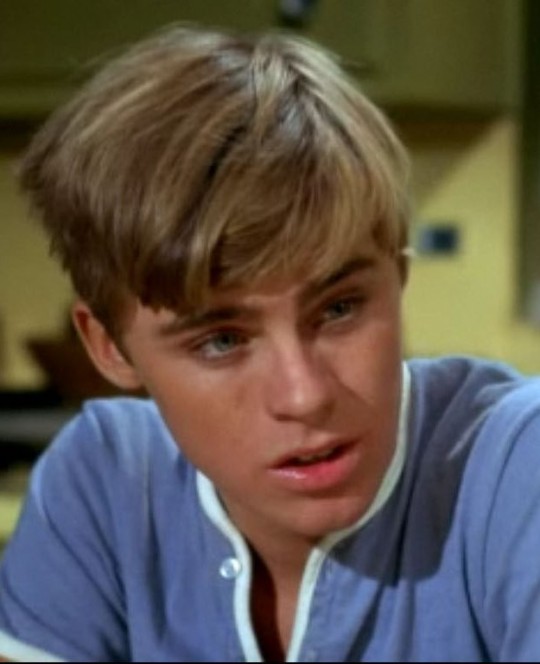
Propaganda
David Cassidy - (The Partridge Family, David Cassidy: Man Undercover) - Cast as the eldest son Keith of TV's musical Partridge Family, David Cassidy convinced the producers that he didn't need to lip synch to a pre-recorded track -- he could sing the lead vocals himself, thank you very much, and a teen heartthrob was born. With his clean-cut good looks and his musical prowess, Cassidy soon had a fan club that was bigger even than those of stars like the Beatles or Elvis Presley. That many fans can't be wrong!
Luke Halpin - (Flipper (season 3)) - Halpin was a good-looking actor of the 1960s who occasionally wore a shirt. At home on and in the water, he did all his own stunts in the Flipper TV series. As his acting career tapered off, he continued to do aquatic stunt work in the movies.
Master Poll List | How to submit propaganda | What is vintage? (FAQ)
Additional propaganda below the cut
David Cassidy:

Cassidy rose to stardom as the lead singer of a fictional family band in "The Partridge Family," being one of only 2 people in the cast who could actually sing (the other being his real-life stepmother, Shirley Jones). At the same time he was in a fake TV band, he also had a real music career as a very successful solo artist. He always felt the tension between his TV teen idol image and the more hard rock style he was striving for in his solo act.
David singing the show's theme song with various photo stills
youtube
31 notes
·
View notes
Text
Top 10 Episodes of "The New Addams Family" (1998)

In 1998, the first ever live action Addams Family TV series since the original premiered on the Fox Family Channel and Fox Kids. Despite being the most over the top and young child friendly incarnation of the Addams Family in live action, the show still did have some bright spots that shouldn't be over looked; which we will be listing today...
youtube
10. Amnesia in the Addams Family - The 90's live action Addams Family series did many adaptations of classic stories from the 1960's show, including one story where Gomez gets amnesia and acts normal. However in the 90's series, the show does a very bizarre twist on that classic tale, and has Gomez's amnesia cause him to act like... Rocky Balboa! It makes no sense from an intellectual standpoint, but seeing Gomez spend the entire episode talking like Sylvester Stalone is a real fun treat.
youtube
9. Thing's Romance - In one of the few episodes focused on the most silent member of the Addams Family, Thing gets a new girlfriend (a female hand named Lady Fingers). What follows is a tale of romance, betrayal, loss, and reunion. As cliche as everything is in this story, the fact that it's happening to two hands makes it real fun to watch. Also... the scene where Thing and Lady Fingers make out is too funny and bizarre for words to describe. ;)
youtube
8. Lurch, the Teen Age Idol - In yet another adaptation of a story taken from the old show, a 1960's episode about Lurch becoming a super star as big as the Beatles is adapted here into a very 90's style tale about Lurch becoming a punk rock star. As much as the Addams Family should always stay the same, sometimes they do have to adapt to the times they're in; and they certainly do in this episode. There's no other decade where you're gonna see Wednesday Addams creating an MTV style music video featuring Lurch doing alternate punk rock. :)
youtube
7. Death Visits the Addams Family - In the series finale, Death (in the form of the Grim Reaper) comes to take Gomez to hell. However in typical Addams Family fashion, every dark concept is played up for laughs; with Gomez acting very casual and calm about his soul perhaps about to be taken to the underworld to be tortured for all eternity. While the resolution is wacky and over the top, the Addams Family's reaction to Death in the first several minutes of the episode really shows the famous creepy family at their kookiest.
youtube
6. Morticia and the Psychiatrist - This episode, a direct adaptation from an early episode of the 60's show: features Pugsley shocking his entire family when he joins the Boy Scouts and starts doing very normie things. The episode changes very little from it's 1960's counterpart, but it doesn't really need to, as the story is still a perfect timeless social commentary on parents worrying about problems their kids have.
youtube
5. Uncle Fester's Illness - When Fester loses his ability to create electricity, the family take Fester to the local hospital, and all sorts of insanity ensue. Wednesday takes advantage of obtaining operating tools that she can use on Pugsley, Morticia basks in the diseases she is surrounded by, and Gomez reveals to the doctors he has the best guaranteed health insurance plan in America... having lots of money! It's a very silly scenario that makes one wonder why other incarnations of the Addams Family haven't already done it.
youtube
4. Addams Family in Court - In a wonderfully dated (in all the right ways) type of story, the Addams Family's neighbors take the Addams Family to court for property damages... with the court actually being a TV court led by a spot on parody version of Judge Judy. However, the real kicker is Fester has a crush on this parody version of Judge Judy, and he only damaged his neighbor's property, just so he could have a chance to ask out his favorite female TV judge. It's this kind of insane plot you can only get with the Addams Family.
youtube
3. Wednesday's Crush - In this rough adaptation of a 1960's episode of the classic series, the family helps out and befriends a normal teenage boy named Sam who has run away from home. However, what makes Sam far more different than typical normies is that he is into dark creepy stuff himself, allowing for the rare opportunity for the Addams Family to make a genuine new friend. However, the rarer moment is when Wednesday (who shows less emotion here than any other incarnation of the character) develops her first crush on Sam. While Sam does not directly reciprocate the goth girl's feelings, he does help Wednesday (for the first time in her life) experience the feeling of being accepted exactly the way she is. Despite all the wacky shenanigans in this episode, there is some real genuine heart underneath it all.
youtube
2. Grandpapa Addams Come to Visit - In this extra special episode, Grandpa Addams comes to visit, and experiences all sorts of wacky shenanigans with the family. While the story is simple enough (even loosely adapting an episode of the 1960's show that told a similar story about Morticia's mother), what elevates this episode far higher is the fact that Grandpa Addams is played by John Astin (Gomez from the 1960's show). The passing of the torch between the original and 90's show is felt very much here, and the respect given to John Astin is felt every second he's on screen. It also doesn't hurt that he gets a lot of great funny moments in this episode as well (such as when Grandpa Addams gets turned on by Morticia speaking French right in front of Gomez).
youtube
1. Morticia's Romance Parts 1+2 - This story may be an adaptation of the identically named two part episode of the 1960's show... but it works just as well here as it did three decades prior. This two part story is essentially a different take on how Gomez and Morticia first met and fell in love. All of the lines and ideas taken from the original 1960's version of the episode still work perfectly here, and many new lines and ideas this version comes up with are also hysterical. It's the origin of how the most passionate couple in all of fiction fell in love. It's hard to go wrong with that.
#wednesday#wednesday addams#addams family#gomez addams#morticia addams#fester addams#top 10#the new addams family#Youtube
7 notes
·
View notes
Text

IT'S HAPPENING - Show Coverage - 1/6/68, Mark Lindsay
1 note
·
View note
Text
youtube
The singer Lonnie Donegan was born on April 29th 1931 in Bridgeton Glasgow.
Donegan was born Anthony James Donegan, the son of a Scottish father and Irish mother. His father was a professional violinist who had played with the Scottish National Orchestra.
He moved with his mother to London at an early age, after his parents divorced. Inspired by blues music and New Orleans jazz bands he heard on the radio, he resolved to learn the guitar, and bought his first at the age of fourteen. He took his first name after a New Orleans blues singer he admired called Lonnie Johnson.
The first band he ever played in was the trad jazz band led by Chris Barber, who approached him on a train asking him if he wanted to audition for his group. Barber had heard that Donegan was a good banjo player; in fact, Donegan had never played the banjo at this point, but he bought one and managed to bluff his way through the audition. His stint in this group was interrupted, however, when he was called up for National Service in 1949.
In 1952, he formed his first own group, the Tony Donegan Jazzband, which found some work around London. On one occasion they opened for the blues musician Lonnie Johnson at the Royal Festival Hall. Donegan was a big fan of Johnson, and took his first name as a tribute to him. The story goes that the host at the concert got the musicians’ names confused, calling them “Tony Johnson” and “Lonnie Donegan”, and Donegan was happy to keep the name.
Donegan recorded a reworking of an American folk tune, Rock Island Line. Decca released the song in 1956, billed by the Lonnie Donegan Skiffle Group. The record, with its talking sequences, homage to Americana, and fast train shuffle climax, became a major hit in Britain and America. Because he was paid a flat fee for the session, Donegan didn’t receive any royalty payments for his most popular and influential song until the label struck a new deal for him 40 years later. However, Rock Island Line made him a star in his own right and would remain his signature song throughout his career.
From 1956 through 1962, he enjoyed a string of 34 British hits including Puttin’ on the Style and Cumberland Gap, which hit number one in 1957, Don’t You Rock Me Daddy-O, which reached number four in the same year, and the raucous sing-along My Old Man’s a Dustman which climbed to the top of the charts in 1960. It’s not hard to see why Lonnie is regarded as the first real pop star, his fans included the likes of Lennon and McCartney, who’s first group, The Quarrymen were a skiffle group. he Shadows, the Searchers, the Hollies, Herman’s Hermits, Gerry & the Pacemakers, and Cliff Richard all began their musical lives doing skiffle.
As the swinging sixties rolled on Donegans hits dried up but he was always in demand for gigs at home and across the world, he also dabbled in a wee bit acting and his own song publishing business, his most popular song he bought the rights for being Nights in white Satin. In the 70’s he popped upon the occasional TV shows during breaks from touring, in 1972 Tom Jones covered one of Lonnie’s songs and it went top 5 on both sides of the Atlantic. As a performer he continued to record and lease unsuccessful sides to Pye, Decca, Black Lion, and RCA.
A 1976 heart attack forced Donegan into an uneasy semi-retirement in California. Two years later, Chrysalis Records organized an all-star recreation of his early hits Puttin’ on the Style. Produced by former British teen idol Adam Faith and boasting duets with Ringo Starr, Elton John, and Rory Gallagher, it was his last major-selling album. Follow-ups with respected session ace Albert Lee and Cajun-fiddler Doug Kershaw seemed to point him towards country music, but a series of heart attacks in 1979 ended his full-time career.
In later years Donegan made a series of guest appearances with old friend Chris Barber including a featured spot on Van Morrison’s Skiffle Sessions: Live in Belfast 1998. Just before his death, he returned to touring full time, exhibiting much of his classic verve and humour before standing-room-only crowds. Donegan died on November 3rd, 2002, in Peterborough.
I've chosen Lonnie singing Me and Bobbie McGee, the reason is in honour of Lonnie, and Kris Kristofferson, who passed away laste year.
5 notes
·
View notes
Text
Richard Chamberlain, Shogun star, dies aged 90
Richard Chamberlain, the actor best known for his role in the 1960s medical drama Dr Kildare and leading role in Shogun, has died aged 90, his publicist has confirmed to the BBC.
Chamberlain earned the title "king of the mini-series" for his leading roles in Shogun and The Thorn Birds.
He died late on Saturday night local time (10:15 GMT Sunday) in Waimanalo, Hawaii, after suffering complications from a stroke, his publicist Harlan Boll confirmed - just hours before he would have turned 91.
Martin Rabbett, Chamberlain's longtime partner, called him an "amazing and loving soul" in a statement.
He said: "Our beloved Richard is with the angels now. He is free and soaring to those loved ones before us."
Rabbett added: "Love never dies. And our love is under his wings, lifting him to his next great adventure."
Chamberlain's big break came in 1961, when he became a household name as Dr James Kildare in Dr Kildare.
The show, based on a popular 1930s and 40s film series, attracted millions of viewers, turning Chamberlain into a beloved leading man and a teen idol.
The popularity Dr Kildare earnt Chamberlain meant that, for three consecutive years between 1963 and 1965, he was named the most popular male star by Photoplay magazine.
He went on to become the king of the 1980s TV mini-series, playing a western prisoner in Shogun and a catholic priest tempted by love in The Thorn Birds.
The latter won 60% of the US television audience and earned 16 Emmy nominations.
Though widely recognised as a romantic leading man, Chamberlain's private life remained largely a mystery until later in his life.
He did not publicly address his sexuality until the release of his memoir, Shattered Love, in 2003, where he revealed that he was gay.
Throughout his 30-year relationship with actor-director Rabbett, they had kept their private life secret.
In his memoir, he recalled escorting glamorous actresses to premieres, explaining that he had been "desperately afraid" his sexuality would derail his career.
"I used to get chased by hot teenage girls," he once told TV Guide. "I got 12,000 fan letters a week. And I felt somewhat besieged."
Rabbett and Chamberlain separated in 2010 but remained close.
Born on 31 March 1934 in Beverly Hills, California, Chamberlain grew up on what he called "the wrong side of Wilshire Boulevard" - far from the wealth of Hollywood's star-studded district.
The younger of two boys, his father, Charles was a salesman and his mother, Elsa, a homemaker.
He initially studied painting at Pomona College, but a student theatre performance inspired him to pursue acting.
Interest from a Hollywood scout was put on hold as he was drafted into the US Army, where he rose to the rank of sergeant while stationed in South Korea.
Upon returning to California, Chamberlain took acting classes, landing several small TV roles before his breakout role as Dr Kildare.
Years later, Chamberlain reflected on his past in his memoir, recounting the emotional burden and abuse of his childhood and the relief of no longer having to hide his sexuality.

5 notes
·
View notes